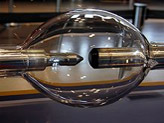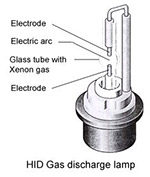What are they?
HID, or high-intensity discharge light bulbs and lamps, are a family of gas-discharge arc lamps which
create light by sending an electrical discharge between two electrodes and through a plasma, or ionized gas.
An additional gas is generally used, and this gas serves as an easy way to classify the major types of HID
lamps: Mercury, sodium, and metal halide.
These lamps are known for their high efficiency at turning
electricity into light and their long rated life. HID lamps require a ballast in order to generate the
initial surge of electricity needed to start them and to regulate their power during normal operation.
Where did they come from?

The basic technology for the gas-discharge lamp has existed for over 300 years,
and these same principals also guided innovations in other lighting types such as fluorescent and neon.
The invention of the gas-discharge lamp is generally credited to Francis Hauksbee, an English scientist,
who first demonstrated the technology in 1705.
At the time, the lamp was filled with air, but it was
later discovered that the light output could be increased by filling the lamp with noble gases, such
as neon, xenon, argon, or krypton.
Modern HID technology has further increased light output through
experimentation in gas mixtures and improved electrodes, but the functional basics of the high-intensity
discharge lamp remain the same.
How do they work?

In modern lighting usage, the HID lamp functions by sending an electric arc between two tungsten electrodes which are housed in an arc tube, usually constructed of quartz. The tube is filled with an amalgam of gas and metal salts.
An arc is created with an initial surge of electricity, facilitated by the gas in the lamp. The arc then heats the metal salts, and a plasma is created.
This increases considerably the light produced by the arc, resulting in a source of light which is more efficient at creating visible light instead of heat than many traditional technologies such as incandescent or halogen lamps.
Where are they used?
Generally speaking, HID lamps are used primarily in applications where the most critical factor is creating as much visible light per watt as possible. Major applications include streetlights, gymnasiums, warehouses, large retail facilities, and stadiums, and plant growing rooms. Recently, these lamps have also been used in some high-end vehicle headlights. Since most HID lamps produce light which is either very cool white/blue or warm white/yellow, they are generally not used in applications where the aesthetic quality of light is important. Also, some HID bulbs require an extended warm up time and are not suitable for applications where lights are turned on and off on a regular basis.
Other Helpful Resources